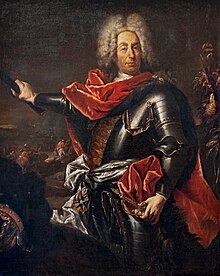
General John Churchill, 1st Duke of Marlborough, 1st Prince of Mindelheim, 1st Count of Nellenburg, Prince of the Holy Roman Empire, was an English soldier and statesman. From a gentry family, he served first as a page at the court of the House of Stuart under James, Duke of York, through the 1670s and early 1680s, earning military and political advancement through his courage and diplomatic skill.

The Battle of Denain was fought on 24 July 1712 as part of the War of the Spanish Succession. It resulted in a French victory, under Marshal Villars, against Dutch and Austrian forces, under Prince Eugene of Savoy.
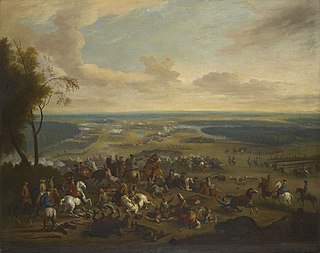
The Battle of Malplaquet took place on 11 September 1709 during the War of the Spanish Succession, near Taisnières-sur-Hon in modern France, then part of the Spanish Netherlands. A French army of around 75,000 men, commanded by the Duke of Villars, engaged a Grand Alliance force of 86,000 under the Duke of Marlborough. In one of the bloodiest battles of the 18th century, the Allies won a narrow victory, but suffered heavy casualties.

The 1695 Siege of Namur or Second Siege of Namur took place during the Nine Years' War between 2 July and 4 September 1695. Its capture by the French in the 1692 and recapture by the Grand Alliance in 1695 are often viewed as the defining events of the war; the second siege is considered to be William III's most significant military success during the war.

The siege of Bouchain, following the Passage of the Lines of Ne Plus Ultra, was a siege of the War of the Spanish Succession, and the last major victory of John Churchill, 1st Duke of Marlborough. Marlborough and François Nicolas Fagel broke through the French defensive lines and took Bouchain after a siege of 34 days. Its capture left Cambrai the only French-held fortress between the allied army and Paris.

The siege of Lille was the salient operation of the 1708 campaign season during the War of the Spanish Succession. After an obstinate defence of 120 days, the French garrison surrendered the city and citadel of Lille, commanded by Marshal Boufflers, to the forces of the Duke of Marlborough and Prince Eugene.

The Battle of Wijnendale was a battle in the War of the Spanish Succession fought on 28 September 1708 near Wijnendale, Flanders, between an allied force protecting a convoy carrying ammunition for the Siege of Lille (1708) and forces of Bourbon France and Spain. It ended in a victory for the allies, leading to the taking of Lille.
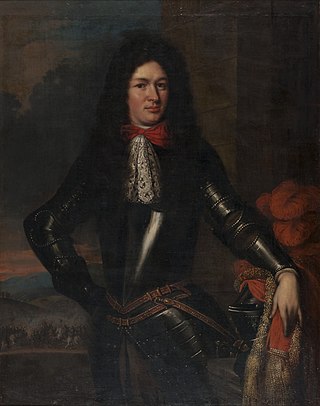
François Nicolas Baron Fagel was an infantry general serving the Dutch Republic. He was a nephew of Gaspar Fagel and took part in many battles during his career. He played an important role in battles such as the Siege of Bonn, the Battle of Malplaquet and the Siege of Bouchain. He was the son of Nicolaas Fagel, mayor of Nijmegen, and Elisabeth Robbé.
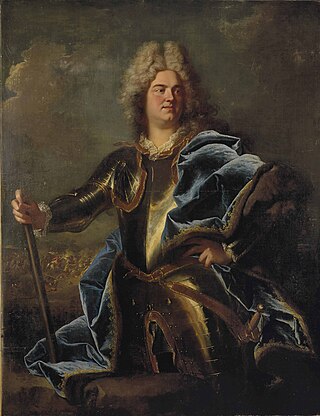
The Rhine campaign of 1713 was a successful French military campaign against the Holy Roman Empire, the sole remaining member of the once-formidable Grand Alliance which had refused to make peace with France. The campaign, which did not result in any pitched battles, ended with French forces besieging and capturing the fortified cities of Landau and Freiburg im Breisgau, which exposed the Palatinate, Württemberg and Swabia to French occupation and compelled the Emperor to sue for peace.
Having been forced to sue for peace with Sweden in 1700, the Danish army was much larger than the kingdom could support. The King decided to put almost half of the army under Allied command during the War of the Spanish Succession. Twelve thousand soldiers were in 1701 made available to the Allied powers in Flanders through a treaty with the Dutch Republic and England. The Danish corps fought under Marlborough at the battles of Blenheim, Ramillies, Oudenarde, and Malplaquet suffering heavy losses. It returned to Denmark in 1713 and 1714.

The siege of Bouchain, was a siege of the War of the Spanish Succession, and a victory for the French troops of the Duc de Villars. A French army of 20,000 men besieged and captured the Allied-controlled fortifications after an 18-day siege, with the 2,000-strong Dutch-Imperial garrison under Major-General Frederik Sirtema van Grovestins capitulating on 19 October.

The siege of Zoutleeuw or the siege of Léau was a siege of the War of the Spanish Succession. Allied troops with 16 artillery pieces under the command of the English Captain general the Duke of Marlborough, besieged and captured the small French-held Flemish fortified town of Zoutleeuw in the Spanish Netherlands.

The siege of Haguenau was a siege of the War of the Spanish Succession. An Imperial army under the command of Field Marshal Johann Karl von Thüngen, besieged and captured the French fortified city of Haguenau on the banks of the Rhine river in Alsace.

Claude Frederic t'Serclaes, Count of Tilly, was a soldier and later general in the Dutch States Army. In the Dutch army he took part in the Franco-Dutch War, Nine Years' War and the War of the Spanish Succession.

The assault on Nijmegen occurred during the War of the Spanish Succession, on 10 and 11 June 1702 involving French troops under the Duc de Boufflers against the small garrison and some citizens of the city of Nijmegen and an Anglo-Dutch army under the Earl of Athlone.

The Bombardment of Arras took place during the War of the Spanish Succession on 2 and 3 March 1712. An Allied army under Arnold van Keppel, Earl of Albemarle closed in on Arras with the aim of destroying the supplies held there. In this way, they hoped that the French would not be able to prevent the sieges of Arras and Cambrai. Although the action succeeded, the advantage had to go entirely unused because the Emperor's troops arrived too late to the Allied army.
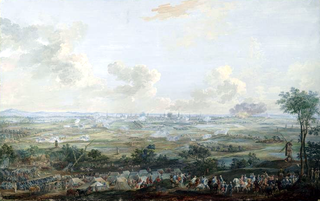
The siege of Tournai was a two-month siege of the city and citadel of Tournai, then part of the Austrian Netherlands, in 1745 during the War of the Austrian Succession. The allied Pragmatic Army's attempt to relieve the siege resulted in the decisive French victory at the Battle of Fontenoy on 11 May. The largely Dutch garrison of the city subsequently surrendered to French forces on 22 May, while the garrison of the citadel surrendered on 19 June 1745. It was one of the longest sieges of the war.

The siege of Mons took place between 19 September and 23 October 1709 during the War of the Spanish Succession. It saw a Franco-Spanish garrison in the fortified town of Mons, then in the Spanish Netherlands, besieged by a force of the Duke of Marlborough's Grand Alliance army under the command of the Prince of Orange.

Daniël Wolf baron van Dopff was a prominent soldier in the Dutch Republic. He was, among other things, general of the cavalry of the Dutch States Army in the War of the Spanish Succession, Quartermaster general of that army, and later commander and governor of the fortress of Maastricht.
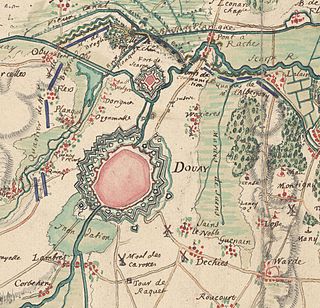
The Siege of Douai, which lasted from 22 April 1710 until the capitulation of the garrison under lieutenant-general François Zénobe Philippe Albergotti on 25 June 1710 was part of the Allied Campaign of 1710 in the War of the Spanish Succession. The siege was conducted under the joint command of the Princ of Orange and Leopold I, Prince of Anhalt-Dessau and successfully concluded despite the fact that halfway through the French army under marshal Claude Louis Hector de Villars, 1st Duke of Villars made an attempt to relieve the fortress city, which led to an indecisive stand-off for four days with the Allied Army under John Churchill, 1st Duke of Marlborough and Prince Eugene of Savoy. After Douai the Allies went on to besiege Béthune.




